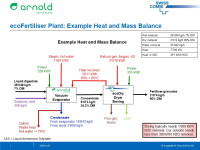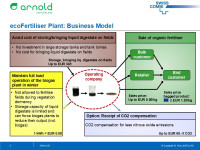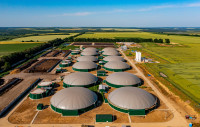Large parts of the world want to move away from fossil fuels and are focussing on biogas and biomethane, among other things. European biogas plants already produce around 22 billion cubic metres of biogas and biomethane, and the European Biogas Association (EBA) expects this volume to increase fivefold by 2050, to up to 167 billion cubic metres . However, more biogas also means significantly more liquid digestate. This raises the question: What to do with it?
Use of fermentation residues as compost and organic fertiliser
Biogas plants produce solid and liquid fermentation residues for which a solution is required. Solid digestate is typically processed into compost, while liquid digestate is spread on the fields. This is usually not a problem for smaller biogas plants, as the liquid digestate can be spread as fertiliser on fields in the surrounding area. If this is not possible, storage and transport to more distant fields involves considerable effort and high costs. The larger the biogas plant and thus the volume of digestate, the greater the challenge.
Large volume due to high water content
The problem with liquid digestate is that, with an average dry matter content of four to six per cent, it consists largely of water, which has to be stored and, above all, transported. The more water can be removed from the liquid digestate, the easier storage and transport will be. This would be possible, for example, by evaporation. The result is a creamy concentrate, which, however, has such a high nutrient density that it cannot simply be spread on the fields. It would have to be diluted with water before spreading, which would be logistically and economically absurd. Therefore, this variant does not really achieve the goal.
Liquid digestate can be dried into fertiliser granulate
Especially with large quantities of liquid digestate, it is worth not only removing some of the water, but actually drying it. Together with Arnold + Partner, SWISS COMBI has developed a process to turn liquid digestate into organic fertiliser granulate that can be spread and stored easily.

Fertiliser granulate made of liquid digestate
Our ecoFertiliser Plant (eFP) combines a vacuum evaporator from Arnold + Partner with our ecoDry drum dryer. The liquid fermentation residues are first processed into a creamy concentrate (evaporator) and then into fertiliser granulate (ecoDry) - and all this in an extremely energy-efficient way.
Energy-efficient drying through heat recovery
In the eFP, around 28 tonnes of liquid digestate are turned into almost 2.6 tonnes of fertiliser granulate - per hour! And with a heat requirement of less than 300 kW/t water extraction, our solution is much more efficient than conventional drying processes, which require more than three times as much heat for water evaporation.

Example heat and mass balance of the SWISS COMBI ecoFertiliser Plant
This is made possible on the one hand by the vacuum evaporator and the ecoDry, which is already designed for high efficiency, and on the other by heat recovery. This involves utilising the waste heat from the ecoDry drum dryer for the vacuum evaporator.
Furthermore, the hot water produced during evaporation could also be used to heat fermentation tanks or buildings - or for a belt dryer, which could dry the solid fermentation residues.
Drying liquid digestate pays off
Drying liquid digestate can be profitable on several levels:
Instead of paying for the field application of the liquid digestate, it can be sold as organic fertiliser and thus open up an additional source of income.
The granulate is easy to store and has a much smaller volume than liquid digestate. This saves the need for large storage tanks and tanker trucks.
When liquid digestate is distributed in the field, nitrous oxide, a potent greenhouse gas, is produced. This can be avoided with granulate. Fewer transport journeys also result in lower CO2 emissions, which has a positive impact on the carbon footprint and may lead to lower costs or even the receipt of compensation payments.

Business Model SWISS COMBI ecoFertiliser Plant
If you would like to find out more about the ecoFertiliser Plant, please contact us!

